

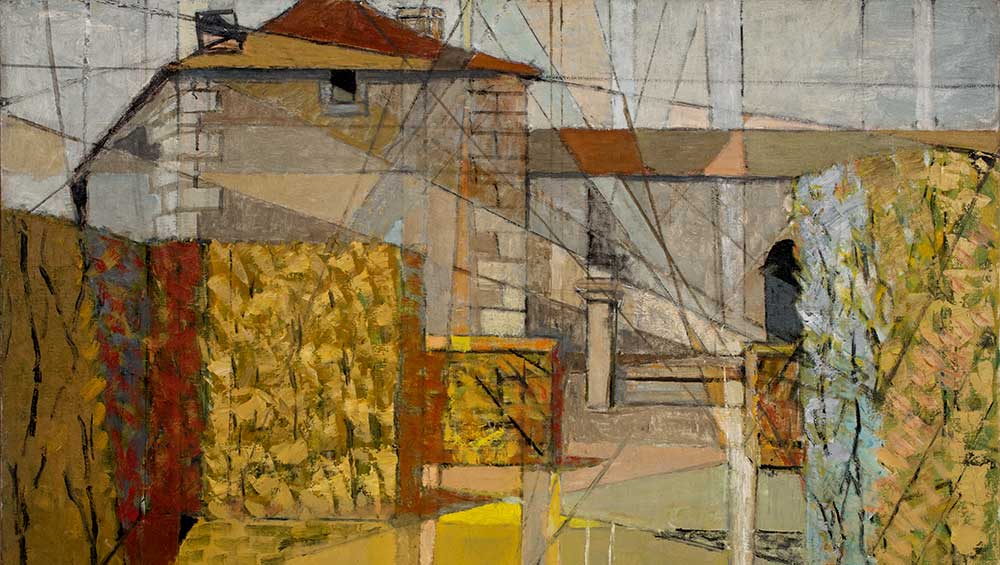
Marguerite Louppe. Vue des buis à Truffières (detail). Oil on canvas, 32.3 x 39.6 in (82 x 100.5 cm). Image courtesy Rosenberg & Co, New York.
by LILLY WEI
The works of Marguerite Louppe (1902-88) are rooted in early modernism, influenced by cubism and purism as well as a host of other movements during a time of aesthetic transition in France, and reflect those of a generation of artists who came of age in the period between the first and second world wars. Louppe’s paintings and works on paper are currently on view in Diagramming Space, a solo exhibition at Rosenberg & Co, her New York debut.
The following is an edited, excerpted conversation with the artist William Corwin, the exhibition’s co-curator.
Lilly Wei: How did you become interested in the work of Marguerite Louppe?
William Corwin: I met David Hirsh at a dinner about 10 years ago and at some point in our conversation, after I told him I was an artist and also wrote about art and had studied art history, he asked me if I might be interested in a collection of artworks he had by two French artists, a married couple named Marguerite Louppe and Maurice Brianchon.
LW: And you were, evidently. Why did you decide to focus on Louppe?
WC: Although Brianchon was more widely known – he had represented France at the Venice Biennale in 1934 and had a retrospective in the Louvre, among other credits – Louppe’s work sounded more interesting to me as David described it that night. After I saw images of her work, it was obvious to me that she had something to offer that was original and should be seen. So, I focused on her and her legacy as the more exciting project.
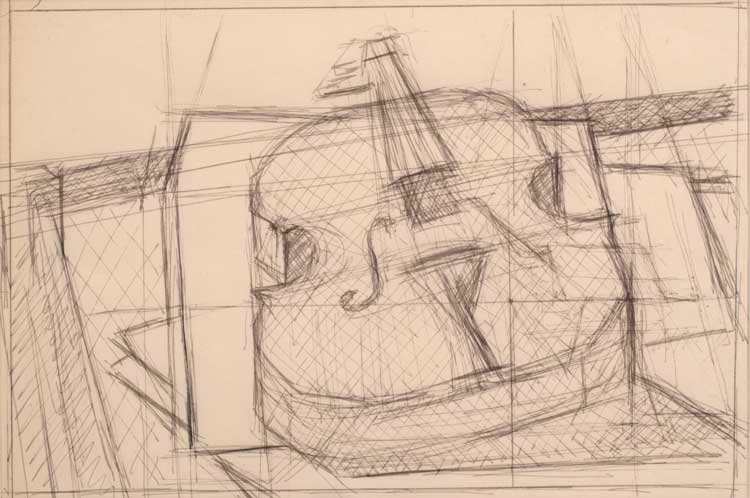
Marguerite Louppe. Étude pour violon. Pencil on paper, 7.5 x 11 in (19 x 28 cm). Image courtesy Rosenberg & Co, New York.
LW: How did Hirsh acquire the works?
WC: The art was left to his family by Louppe and Brianchon’s son, an only child who never married; he was close to David’s parents and to him. They were also distant relatives. Pierre-Antoine, the son, had occasionally sold a few of his father’s paintings but, mostly, he just sat on the collection so when David and his family inherited it after his death in 2012, it had been in storage for some time.
LW: And then Hirsh invited you to France?
WC: Yes, the initial viewing took place in Toulon, where I stayed in a large house on the Mediterranean (Matisse had stayed there as had many other artists) and then I returned a few months later, and went through the works in the farmhouse in the Dordogne that had been Marguerite and Maurice’s home. It was very atmospheric and also very cold since it was the winter, but it was wonderful to see art that hadn’t been seen in decades.
Marguerite was certainly aware of her times, assessing the art around her and experimenting with ways to produce her own vision of the world. I spent a couple of months going through the 100-plus canvases, categorising them according to stylistic trends and subject matter, which consisted mainly of landscapes, portraits and still lifes. It was a dream project for me, but a lot of research was involved. For instance, she never dated her works, so I had to create a timeline, and do a lot of cross-referencing, sometimes using reviews of her work to date them. This included a search for an official birth certificate. Otherwise, even her existence would be hearsay.
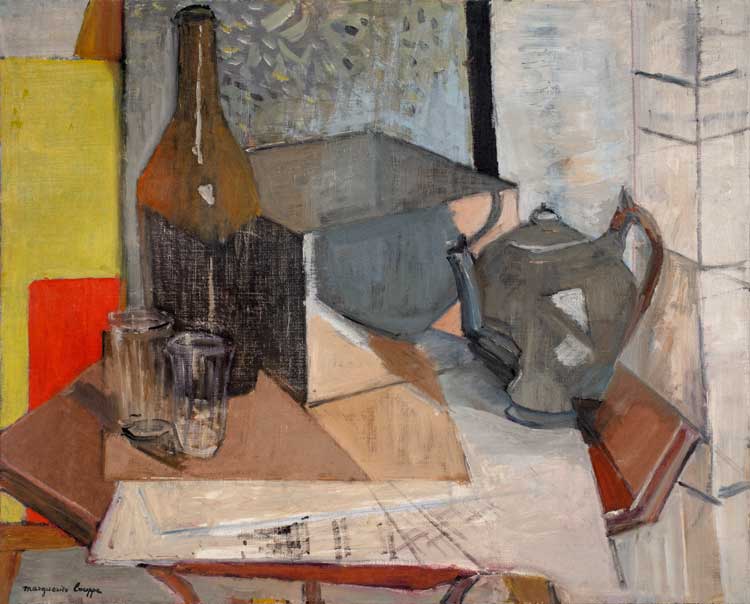
Marguerite Louppe. Nature morte à la théière. Oil on canvas, 25.6. x 31.7 in (65 x 80.5 cm). Image courtesy Rosenberg & Co, New York.
LW: Did you have a strategy for introducing her work in the United States?
WC: Yes, I contacted smaller university art museums with art history departments that taught 20th-century French art. They were eager for content, and Louppe and Brianchon were excellent representatives of trends from the 1930s to 1960s and of mid-century creativity. I also paired Marguerite with Perle Fine. They were two female artists living parallel lives, one in Paris and the other in New York, and I thought it would be insightful to experience modernism through their eyes. And while I can’t prove it, Marguerite most likely saw Perle’s work since she showed in Paris and Marguerite would have been interested in it.
LW: How did the Rosenberg gallery become involved?
WC: There was an exhibition at the gallery in the summer of 2021, A Future We Begin to Feel: Women Artists 1921-1971, and they got in touch with me about writing an essay for it. Marie Laurencin was included, whom Paul Rosenberg, the gallery’s founder, had represented and so was Perle Fine. I asked about Marguerite, but they didn’t know her work. They thought it was fantastic after seeing it and included her in the show. That’s how the association started.
LW: You said that too many women from the early days of modernism, like Louppe, have been overlooked. So how does the unknown become known?
WC: They just need to be seen, to be evaluated, to have their day in court. Their work, obviously, is as good as that of any of the men; it’s bizarre that women were considered to be inferior painters. This show now at Rosenberg is Marguerite’s first solo show in the US and the largest solo she’s had yet. This is her first chance for a more comprehensive viewing.
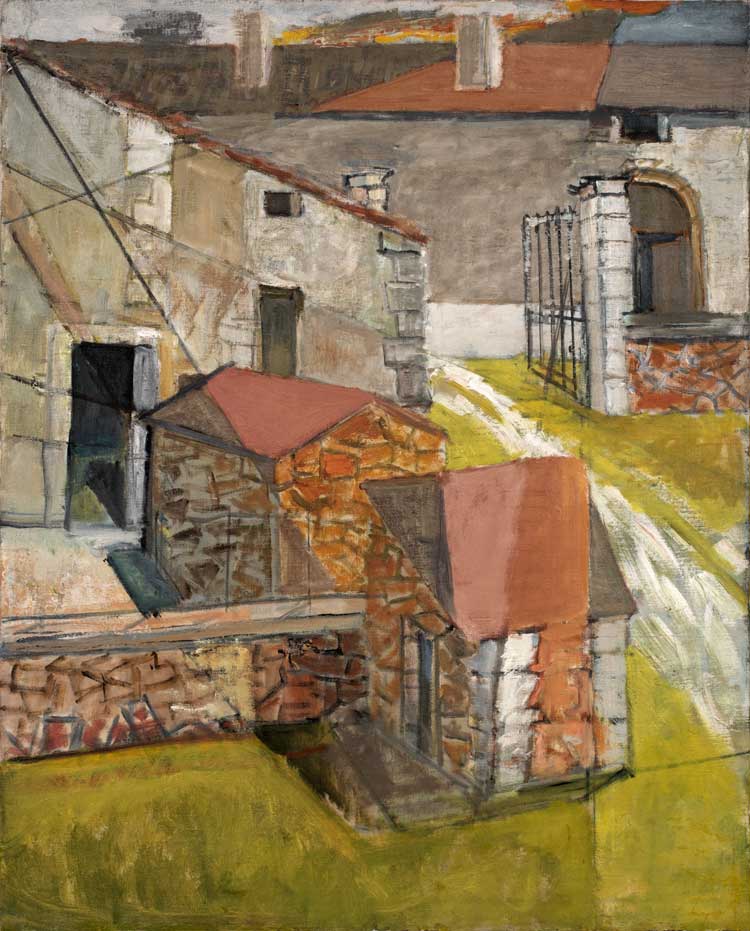
Marguerite Louppe. Vue de l'atelier de Maurice Brianchon. Oil on canvas, 31.38 x 25.25 in (79.7 x 64.1 cm). Image courtesy Rosenberg & Co, New York.
LW: Would you talk a little about Louppe’s life?
WC: She was born in Commercy in 1902, but her family moved to Paris soon after. She attended the Lycée Molière, a public girls’ school. It was not a Catholic school, so there was a great mix of backgrounds. It was far more rigorous than the usual Catholic school education. The men in her family were prominent engineers as well as businessmen and scientists. When she graduated from the lycée, she attended several Parisian open academies: the Académie Julian (Julian realised that to open up to women would be remunerative since they didn’t have many places to study); the Académie André Lhote; the Académie de la Grande Chaumière; and others. Louise Bourgeois attended the progressive Académie Julian, as well as Jean Dubuffet, Marcel Duchamp, and so many others – it was a great mix, overrun with Americans and artists from different countries. She did that for a couple of years and then met Maurice. He had studied at the École des Arts Décoratifs in Paris and had a more expansive training in art beyond painting.
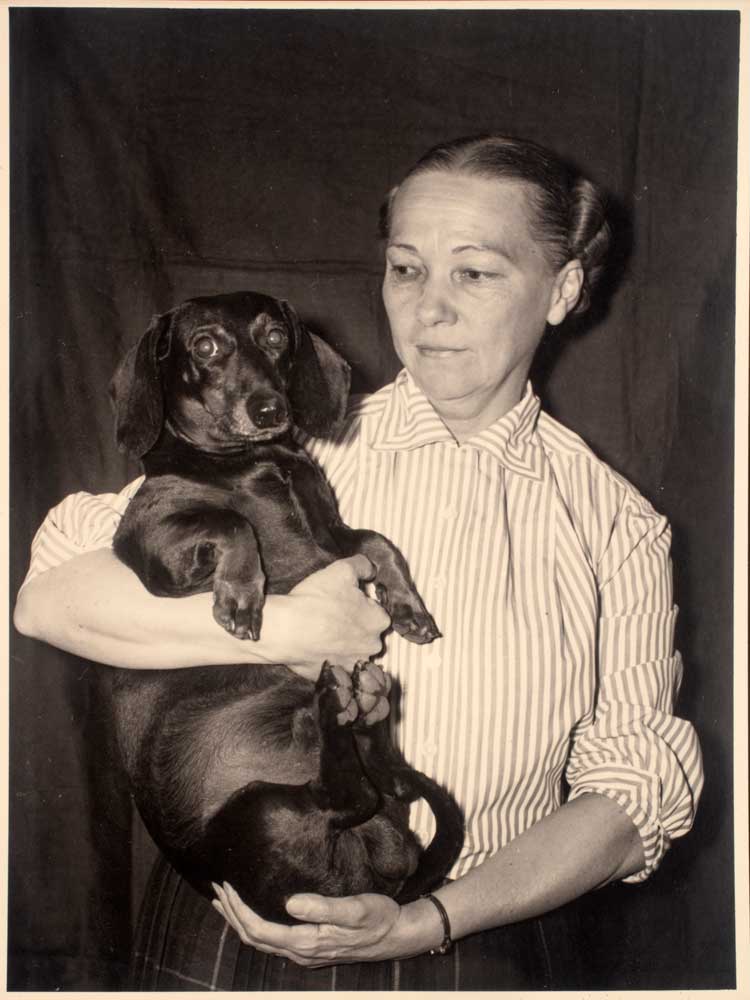
Marguerite Louppe portrait. Image courtesy Rosenberg & Co, New York.
They were dedicated to their work and created a harmonious life and working partnership, first in Paris, and later in Dordogne, purchasing a country house there in the early 50s where she was able to have her own studio for the first time – and a very spacious one. They collaborated on numerous projects that included textile design, set design, book illustrations and so on. One ambitious project was a wall painting they did together, but I don’t think it still exists, and Marguerite organised her husband’s retrospective at the Louvre in 1951. They were clearly a team, but their practices were very different, and they retained their own aesthetic sense and independence while living together. Maurice was very supportive of Marguerite’s work. They didn’t keep diaries and there’s not a lot of correspondence between them, so all we can go by is the data that shows that collaboration. For instance, she often had shows at galleries where he showed, most likely at his suggestion. It was Brianchon who made the money.
LW: It seems the typical arrangement of couples in the 50s, with the man as the wage earner – even if unusual in that he acknowledged and even respected her as an artist.
WC: Yes, it was. But it gave her more time in the studio in which to experiment, free from economic considerations.
LW: How would you describe her process, her artistic practice?
WC: Marguerite’s earliest work was indebted to Édouard Vuillard, Pierre Bonnard and other impressionists and post-impressionists: Parisian street scenes, women in boudoirs dressing with a bit of drama. She was very much immersed in the School of Paris, adding her own intensity of emotion and a novel way of dealing with paint. And it should be remembered that she wasn’t unknown. There are nice examples of that period of her work in the Pompidou. Also, in trying to establish her trajectory as an artist, I created a hashtag for her and found, to my surprise, that she already had one in Helsinki.
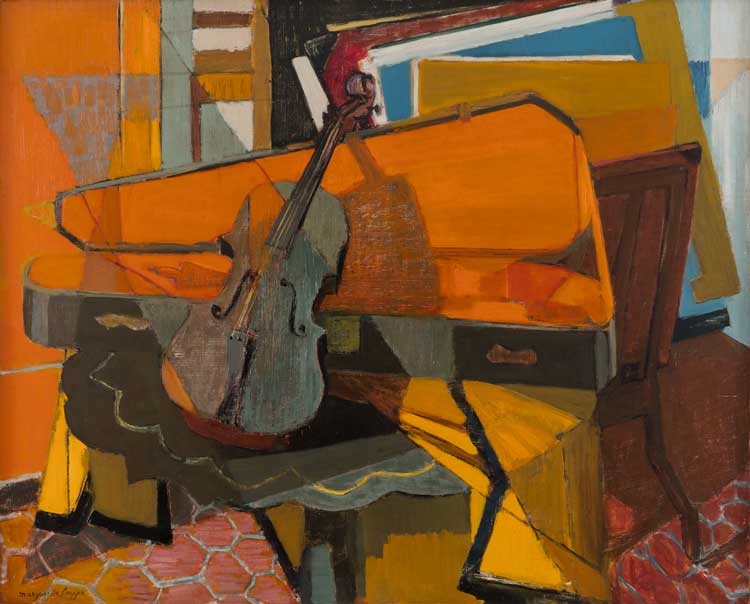
Marguerite Louppe. Le violon rouge. Oil on canvas, 31.5 x 38.75 in (80 x 98.4 cm). Image courtesy Rosenberg & Co, New York.
LW: Several of her works here are clearly investigating cubism.
WC: That was the next stage, her interest in cubism and the geometricisation of objects. There is a wonderful drawing of a realistic violin and a similarly composed painting, The Red Violin (Le Violon Rouge) that is much more cubist. And her hallmark technique of lines radiating from objects appeared by the late 30s. The critic Saul Ostrow points out the connections between cubism and her work, but another critic made a fascinating connection between her work and Jacques Villon. She and Maurice spent time with Villon, including a trip to Rome, and there are letters they wrote to each other.
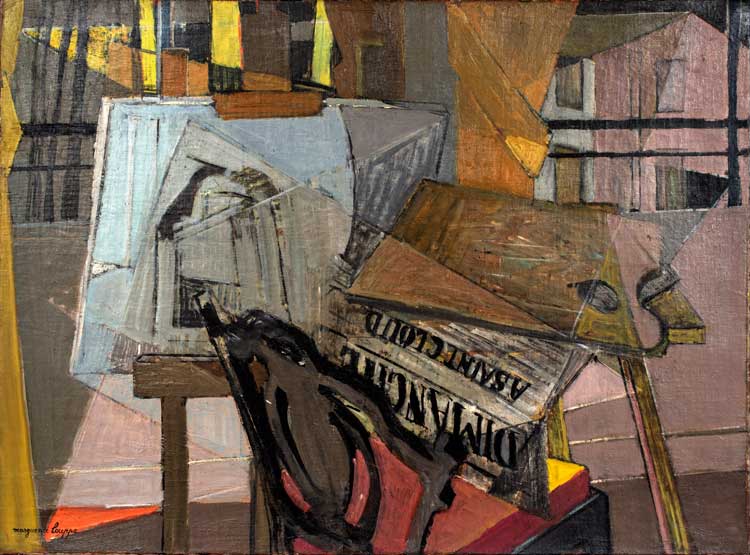
Marguerite Louppe. Dimanche à Saint Cloud. Oil on canvas, 23 x 31.75 in (58.4 x 80.6 cm). Image courtesy Rosenberg & Co, New York.
LW: You said she was also interested in purism, in Le Corbusier and Amédée Ozenfant?
WC: She was very aware of the engineering and architectural side of things. Her work is exciting when she creates a geometric plane and then shows you what she can do within that plane. One of the most recurrent objects in her vocabulary is a draftsman’s triangle, which functions as both emblem and part of her biography, a nod to her family’s legacy. When they moved to Dordogne, still lifes of her studio with canvases, painting brushes, notebooks, of commonplace objects of daily life, including a compotier that appears often, became increasingly important, as did landscape. And she continued to experiment, becoming more abstract in her late years.
LW: Maurice died in 1979?
WC: Yes. One detail I thought was interesting was that his will forbade any exhibitions of his works for 10 years, which spared Marguerite the burden of dealing with his estate. She was in failing health and became blind in her last years, dying in 1988.
LW: How were the works for this show selected?
WC: When we started to talk about it, we decided that no theme was necessary. What was important was that it be seen, just seen, and that it should be a survey, focusing on mature works. The question was: how do you present an artist’s entire life in four rooms?
LW: How do you?
WC: Well, we thought the viewer should be given a sense of her range. There are still lifes that are dark and some that are chromatically muted and there are several beautiful and very colourful paintings of flowers as well as domestic scenes, landscapes and some drawings and etchings.
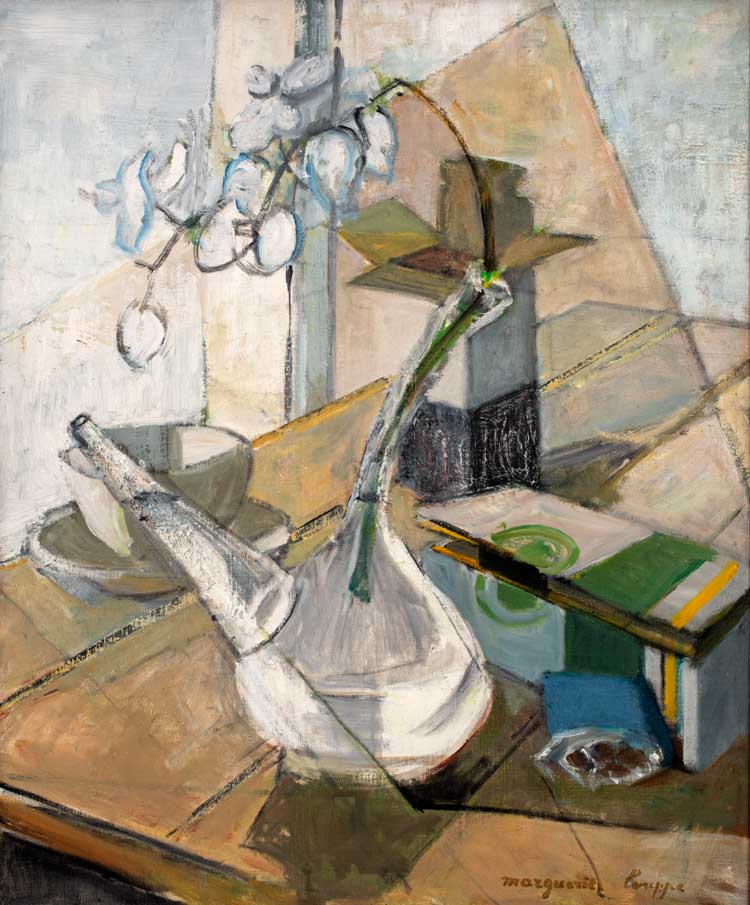
Marguerite Louppe. Carafe et orchidée. Oil on canvas, 25.25 x 21 in (64.1 x 53.3 cm). Image courtesy Rosenberg & Co, New York.
LW: What works of hers most intrigue you?
WC: I’m most interested in her geometric compositions that analyse space. And there is a room of her drawings in the show that maps the objects, like architectural plans. She loved to look at her studio from an engineer’s point of view. And everything in her paintings meant something to her. When she makes a still life, the objects relate to each other so that each has a story. My favourites are the table-top works. They are very powerful; you can get lost in them and in their architectural arrangements, in her cubist bending of space.
LW: Even though she showed consistently in her lifetime, her work was not really seen, was it? It is hard to remember just how disregarded women artists were until the last couple of decades, and even now, parity has not been achieved.
WC: She and artists like her, with significant bodies of work, were marginalised, yet they are part of mid-century French art history and must be assessed. Is she a great artist? And this is a point that I keep returning to – she is certainly as accomplished an artist as male contemporaries who were much more successful. Perhaps now, her work will really be looked at. Perhaps now, it can be judged with less bias because of the more inclusive attitudes of this generation.
• Marguerite Louppe: Diagramming Space, co-curated by William Corwin, is at Rosenberg & Co, New York, until 1 July 2020.